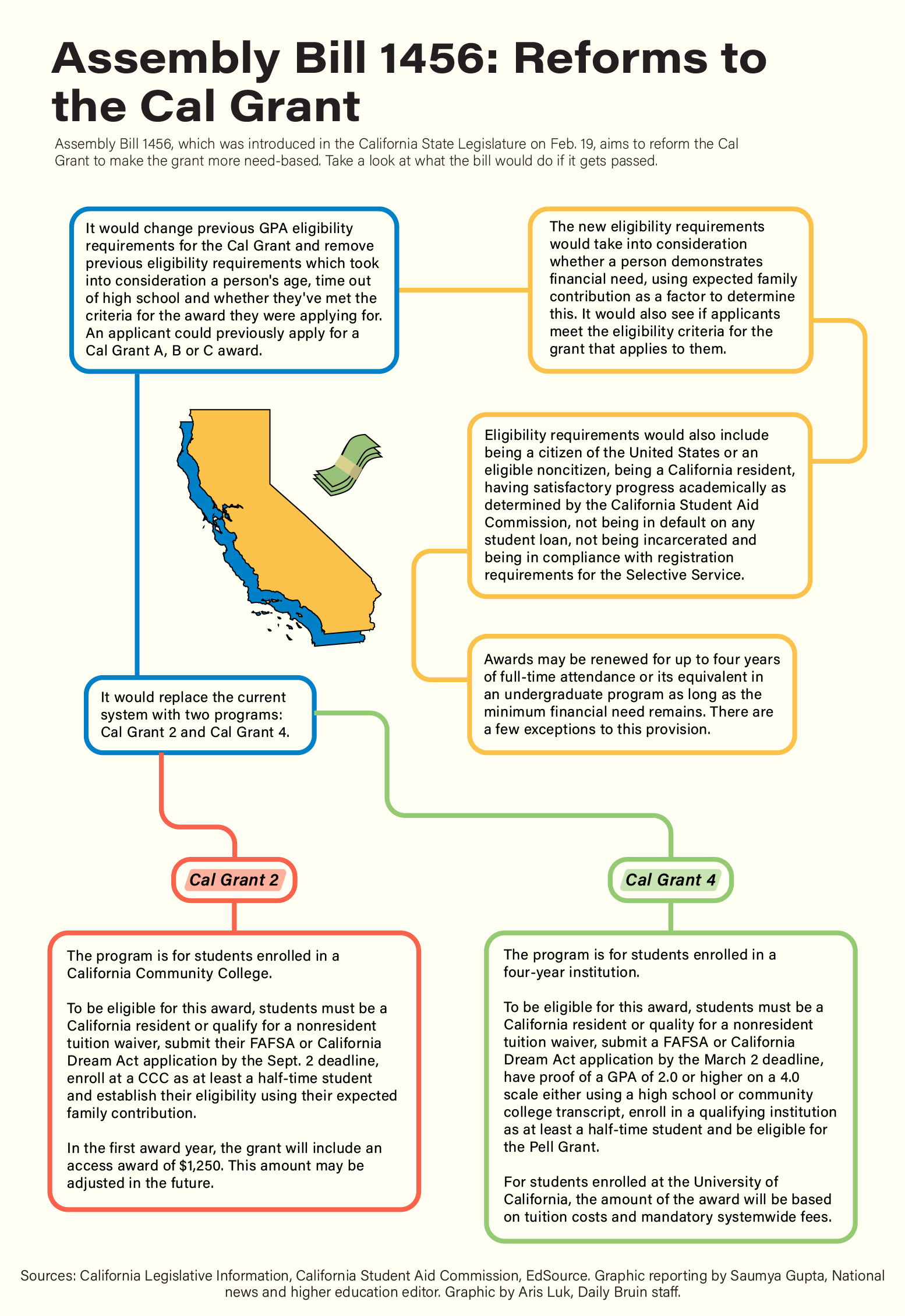Faculty discuss advantages, drawbacks of proposed Cal Grant reforms under AB 1456

By Emily Kim
March 5, 2021 4:53 p.m.
This post was updated March 7 at 9:31 p.m.
The newly proposed bill to reform the Cal Grant system could make it easier for low-income students to receive funds, but will reduce the award amounts, UCLA faculty said.
Assembly Bill 1456, introduced by California state assembly members Kevin McCarty and Jose Medina on Feb. 19, aims to simplify the current Cal Grant program by implementing two separate grants for college students: Cal Grant 2 for community college students and Cal Grant 4 for four-year university students. These two grants would replace the current system consisting of Cal Grants A, B and C and aim to make 197,000 additional students eligible for Cal Grants.
The two grants would reduce the requirements to be eligible for the Cal Grant. Cal Grant 2 eliminates the time out of high school and age requirements and disposes of the minimum GPA requirement. Cal Grant 4 similarly removes the time out of high school and age requirements and reduces the minimum GPA requirement to a 2.0.
Both Cal Grant 2 and Cal Grant 4 would primarily use expected family contribution to determine financial need, and part-time students would receive the same award amount as full-time students.
However, some UCLA professors said that there are both benefits and detriments for UCLA and its students.
Bill Purdy, an education lecturer, said he believes UCLA would benefit philosophically from the bill. Expanding students’ access to higher education financially would mark a significant philosophical shift in making access to higher education more equitable, and UCLA would benefit from being a part of it, he said.
However, Val Rust, an education professor emeritus, said providing more aid to community colleges would increase community college enrollment and could disincentivize students from coming to UCLA because community colleges would be cheaper to attend.
The current Cal Grant program is competitive, as approximately 300,000 eligible applicants vie for 41,000 grants every year, according to the California Student Aid Commission. Under the reformed system outlined by the bill, more applicants will be eligible to receive aid; however, aid amounts will decrease with more students receiving aid, according to a CSAC addendum.
According to the addendum, Cal Grant 2 participants will receive a $1,250 award for nontuition expenses, down from the $1,656 award that Cal Grant B students receive currently.
With Cal Grant 4, students at the University of California and California State University would still receive full tuition and fees coverage as long as their expected family contribution is at or below $5,576, but they would no longer be eligible for Cal Grants that cover nontuition costs, the addendum adds.
Gary Orfield, a distinguished research professor in education, said he is concerned the reforms would make UC and CSU students ineligible for nontuition aid.
“I’ve had students who can’t buy books (and) can’t afford a place to live,” Orfield said.
Low-income students without adequate support need to be supported, regardless of whatever campus they attend, he added.
Many community college students live at home, while UC and CSU students tend to live on campus. This means that UC and CSU students often contend with greater nontuition living expenses than community college students, Orfield said.
Students who would qualify for Cal Grant 4 would have to look internally to their own colleges for support and aid in nontuition costs, Medina said.
However, the feasibility of shifting the burden onto university and state resources is uncertain, Rust said.
“We don’t have any money,” Rust said. “UCLA would have to come up with the money to pay for what the students are now receiving from the state in terms of nontuition costs.”
While some financial elements of the plan remain uncertain, the reforms intend to address issues of equity within the Cal Grant system by reducing eligibility requirements, increasing the number of awards given and making the program more easily navigable to applicants through the two-option revision, according to a CSAC press release.
The current Cal Grant program has eligibility barriers that restrict students from accessing financial aid based on factors outside of their financial status, said Jake Brymner, CSAC director of government and external relations.
The proposed reforms would most benefit students from low-income groups, including many older students, students with dependents, adult learners and students of color seeking higher education, according to CSAC.
The proposal to provide financial aid to all eligible students is expensive, projected to cost hundreds of millions of dollars; however, the feasibility and scale of the required funding is still uncertain, Medina said.
The bill still needs to be voted on in the Assembly before it reaches the state Senate.
Orfield added that while this bill seeks to address issues in the financial aid system, inadequate money is one of the most significant problems in fixing it.
“The problem is (our) limited amount of money,” Orfield said. “All of this is well-motivated, and there are too many needy kids in California.”


